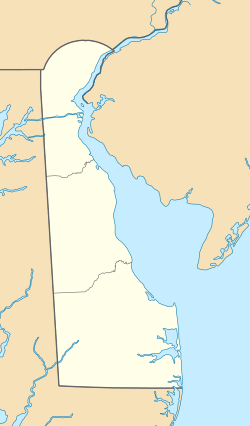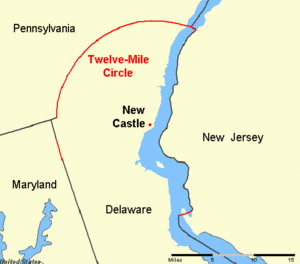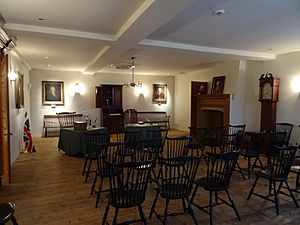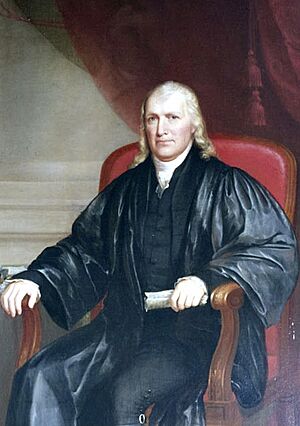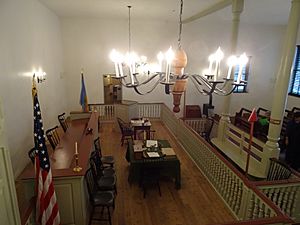New Castle Court House Museum facts for kids
|
New Castle Court House Museum
|
|
|
U.S. National Historic Landmark District
Contributing Property |
|
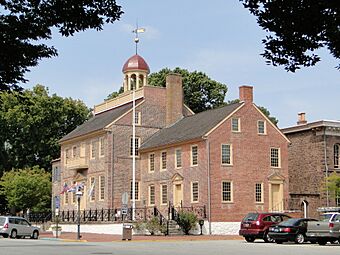
New Castle Court House Museum
|
|
| Location | 211 Delaware St., New Castle, Delaware |
|---|---|
| Built | 1730 |
| Architectural style | Georgian |
| Part of | New Castle Historic District (ID67000003) |
| NRHP reference No. | 72000285 |
Quick facts for kids Significant dates |
|
| Added to NRHP | November 28, 1972 |
| Designated NHL | November 28, 1972 |
| Designated NHLDCP | December 24, 1967 |
The New Castle Court House Museum is a very old and important building in New Castle, Delaware. It's famous because it's the center of a special 12-mile circle. This circle helps define most of the border between Delaware and Pennsylvania. It also marks parts of the borders with New Jersey and Maryland.
This building is one of the oldest courthouses in the United States. Many important historical events happened here. In 1972, it was named a National Historic Landmark. This means it's a place of great historical value. The Court House is also part of the New Castle Historic District, which is another National Historic Landmark. Today, it is part of First State National Historical Park.
Contents
History of the Court House
The 12-Mile Circle and State Borders
In 1682, James, the Duke of York, gave William Penn land around New Castle. This land was defined by a 12-mile circle. Soon after, Lord Baltimore of Maryland disagreed about these borders. This started an 87-year legal fight between the two families.
In 1732 and 1733, a special group met at the New Castle Court House. They tried to solve the border problem. Later, in 1750, another group agreed that the top of the Court House building would be the exact center of the 12-mile circle.
The famous surveyors Charles Mason and Jeremiah Dixon helped in 1763. They used the Court House as their starting point. They drew a straight 12-mile line from it. Their work helped create the Mason–Dixon line. This line became a well-known dividing line between the northern and southern states. The border dispute was finally settled in 1769.
New Jersey also argued about the circle's borders starting in 1820. They disagreed about who owned Pea Patch Island in the river. After many discussions and court cases, it was decided that the 12-mile circle was valid. This meant the island belonged to Delaware. The Supreme Court of the United States has looked at this border many times, even as recently as 2007.
Early American Government and Independence
The first known courthouse on this spot was built in 1687. This building was used for both court cases and government meetings. The colonial assembly, which made laws, sometimes met here. In 1700, William Penn himself attended a meeting in the Court House.
In 1704, the three counties of Delaware decided they wanted their own assembly. They wanted to make their own laws, separate from Pennsylvania. From then on, the assembly meeting in the Court House governed only Delaware.
The original building was mostly destroyed by a fire in 1729. A prisoner trying to escape caused it. The Court House was rebuilt quickly in about a year. You can still see parts of the old foundation today.
In 1774, the assembly met here and chose three important Delaware leaders. These were Thomas McKean, Caesar Rodney, and George Read. They would represent Delaware in the Continental Congress. On June 13, 1776, the assembly voted to break away from England. They also decided to separate from Pennsylvania. This was a huge step towards Delaware's independence.
When the United States Declaration of Independence was issued, it was read to the people of New Castle. This reading happened from the second-floor balcony of the Court House. Later in 1776, Delaware's first Constitution was written and approved inside this building. This made Delaware the first state to adopt its own constitution after the Declaration.
The Court House served as Delaware's first capital city until 1777. That year, the British captured Philadelphia and Wilmington. Delaware's government then moved to Dover, which became the new capital. The building continued to host court cases until 1888.
In 1804, a famous architect named Benjamin Henry Latrobe visited New Castle. He designed the United States Capitol building. Latrobe and his students drew detailed pictures of the Court House. These drawings were very helpful for later repairs and updates to the building.
The Samuel Chase Trial
In 1800, U.S. Supreme Court Justice Samuel Chase held court at the New Castle Court House. He wanted to charge certain newspapers with breaking laws. The jury did not agree to charge anyone. But Justice Chase refused to let them go. He insisted they look at the town's newspapers.
Justice Chase was later accused of misusing his power. In 1804, he became the first, and only, Supreme Court Justice to be tried by the House of Representatives. One of the charges against him was about his actions in the New Castle Court House. The House said he acted like an "informer" instead of a fair judge. They said he refused to let the jury go, even when they asked.
Chase defended himself by saying he had a duty to report broken laws. The Senate found him not guilty of the charges. Even though he was not removed, this event was a big part of American legal history.
The Penn Family Lawsuit
In 1801, John and Richard Penn, who were heirs of William Penn, filed a lawsuit. They wanted money for lands in Delaware that they said belonged to them. This case was heard at the New Castle Court House in 1804.
Many famous lawyers were involved in this case. The Penns had a strong legal team. The state of Delaware was represented by important figures like Caesar A. Rodney and James A. Bayard Sr..
The judge, Justice Samuel Chase, decided that the court could not hear the case. A law that allowed the lawsuit had been canceled. He said that a repealed law is "dead" and has no power. This ended the Penns' attempt to get money for the lands.
Trials for Helping Enslaved People
One of the most famous trials in the Court House happened in 1848. Two well-known abolitionists, Thomas Garrett and John Hunn, were put on trial. They were accused of helping enslaved people escape. This was against the Fugitive Slave Act.
U.S. Chief Justice Roger Taney was the judge. Garrett was defended by his friend, U.S. Senator John Wales. The prosecution was led by James A. Bayard Jr..
Both Garrett and Hunn were found guilty. They were given very large fines. These fines were so big they made both men lose all their money. But Garrett and Hunn bravely said they would keep helping enslaved people find freedom.
After the trials, Thomas Garrett wrote to Harriet Beecher Stowe. Four years later, she used these events as inspiration for her famous book, Uncle Tom's Cabin. Garrett was a main inspiration for the character of Simeon Halliday. By the time the Civil War started, Garrett had helped 2,700 enslaved people escape to freedom.
Justice Taney later made a very controversial decision in the Dred Scott case in 1857. He ruled that Black people could not be American citizens.
Museum and National Park
The New Castle Court House became a museum in 1963. It is now part of the First State National Historical Park. The park's main office and visitor center are in the Sheriff's House, right next to the Court House.
This National Historical Park was created to protect and share the history of the region. It tells the story of how the Swedes, Dutch, and English settled here. It also highlights Delaware's important role in forming the United States. Delaware was the first state to approve the U.S. Constitution.
See also


